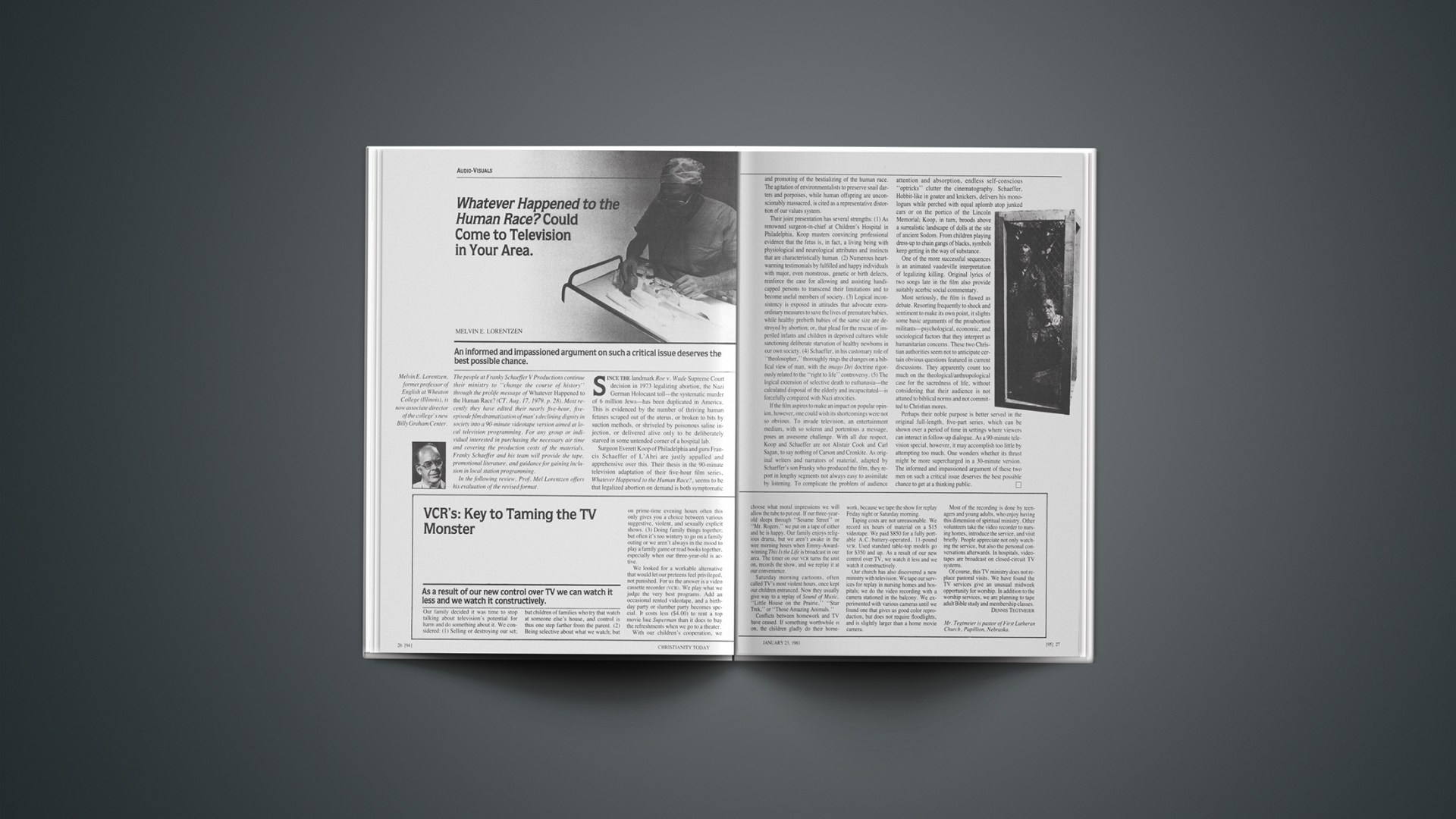An informed and impassioned argument on such a critical issue deserves the best possible chance.
The people at Franky Schaeffer V Productions continue their ministry to “change the course of history” through the prolife message of Whatever Happened to the Human Race? (CT, Aug. 17, 1979, p. 28). Most recently they have edited their nearly five-hour, five-episode film dramatization of man’s declining dignity in society into a 90-minute videotape version aimed at local television programming. For any group or individual interested in purchasing the necessary air time and covering the production costs of the materials, Franky Schaeffer and his team will provide the tape, promotional literature, and guidance for gaining inclusion in local station programming.
In the following review, Prof. Mel Lorentzen offers his evaluation of the revised format.
Since the landmark Roe v. Wade Supreme Court decision in 1973 legalizing abortion, the Nazi German Holocaust toll—the systematic murder of 6 million Jews—has been duplicated in America. This is evidenced by the number of thriving human fetuses scraped out of the uterus, or broken to bits by suction methods, or shriveled by poisonous saline injection, or delivered alive only to be deliberately starved in some untended corner of a hospital lab.
Surgeon Everett Koop of Philadelphia and guru Francis Schaeffer of L’Abri are justly appalled and apprehensive over this. Their thesis in the 90-minute television adaptation of their five-hour film series, Whatever Happened to the Human Race?, seems to be that legalized abortion on demand is both symptomatic and promoting of the bestializing of the human race. The agitation of environmentalists to preserve snail darters and porpoises, while human offspring are unconscionably massacred, is cited as a representative distortion of our values system.
Their joint presentation has several strengths: (1) As renowned surgeon-in-chief at Children’s Hospital in Philadelphia, Koop musters convincing professional evidence that the fetus is, in fact, a living being with physiological and neurological attributes and instincts that are characteristically human. (2) Numerous heartwarming testimonials by fulfilled and happy individuals with major, even monstrous, genetic or birth defects, reinforce the case for allowing and assisting handicapped persons to transcend their limitations and to become useful members of society. (3) Logical inconsistency is exposed in attitudes that advocate extraordinary measures to save the lives of premature babies, while healthy prebirth babies of the same size are destroyed by abortion; or, that plead for the rescue of imperiled infants and children in deprived cultures while sanctioning deliberate starvation of healthy newborns in our own society. (4) Schaeffer, in his customary role of “theolosopher,” thoroughly rings the changes on a biblical view of man, with the imago Dei doctrine rigorously related to the “right to life” controversy. (5) The logical extension of selective death to euthanasia—the calculated disposal of the elderly and incapacitated—is forcefully compared with Nazi atrocities.
If the film aspires to make an impact on popular opinion, however, one could wish its shortcomings were not so obvious. To invade television, an entertainment medium, with so solemn and portentous a message, poses an awesome challenge. With all due respect, Koop and Schaeffer are not Alistair Cook and Carl Sagan, to say nothing of Carson and Cronkite. As original writers and narrators of material, adapted by Schaeffer’s son Franky who produced the film, they report in lengthy segments not always easy to assimilate by listening. To complicate the problem of audience attention and absorption, endless self-conscious “optricks” clutter the cinematography. Schaeffer, Hobbit-like in goatee and knickers, delivers his monologues while perched with equal aplomb atop junked cars or on the portico of the Lincoln Memorial; Koop, in turn, broods above a surrealistic landscape of dolls at the site of ancient Sodom. From children playing dress-up to chain gangs of blacks, symbols keep getting in the way of substance.
One of the more successful sequences is an animated vaudeville interpretation of legalizing killing. Original lyrics of two songs late in the film also provide suitably acerbic social commentary.
Most seriously, the film is flawed as debate. Resorting frequently to shock and sentiment to make its own point, it slights some basic arguments of the proabortion militants—psychological, economic, and sociological factors that they interpret as humanitarian concerns. These two Christian authorities seem not to anticipate certain obvious questions featured in current discussions. They apparently count too much on the theological/anthropological case for the sacredness of life, without considering that their audience is not attuned to biblical norms and not committed to Christian mores.
Perhaps their noble purpose is better served in the original full-length, five-part series, which can be shown over a period of time in settings where viewers can interact in follow-up dialogue. As a 90-minute television special, however, it may accomplish too little by attempting too much. One wonders whether its thrust might be more supercharged in a 30-minute version. The informed and impassioned argument of these two men on such a critical issue deserves the best possible chance to get at a thinking public.










